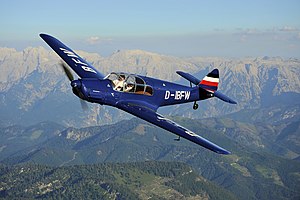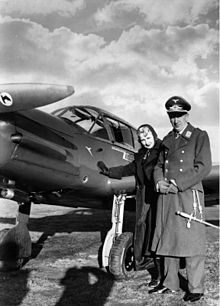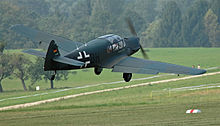

| Bf 108 Taifun | |
|---|---|

| |
| D-EBFW, a 1937-built Bf 108B-1 painted to represent a pre-war company demonstrator D-IBFW | |
| Role | Sport and touring aircraft
Type of aircraft
|
| Manufacturer | Bayerische Flugzeugwerke |
| Designer | Willy Messerschmitt |
| First flight | 1934 |
| Introduction | 1935 |
| Retired | 1945 |
| Primary users | Luftwaffe Armée de l'Air Manchukuo National Airways |
| Number built | 885[1] |
| Variants | Nord 1000 Pingouin Nord Noralpha |
The Messerschmitt Bf 108 Taifun (English: "Typhoon") was a German single-engine sport and touring aircraft, developed by Bayerische Flugzeugwerke in the 1930s. The Bf 108 was of all-metal construction.
Originally designated the M 37, the aircraft was designed as a four-seat sports/recreation aircraft for competition in the 4th Challenge International de Tourisme (1934).[2][3] The M 37 prototype flew first in spring 1934, powered by a 250 PS (247 hp, 184 kW) Hirth HM 8U 8.0 litre displacement, air-cooled inverted-V8 engine, which drove a three-blade propeller.
Although it was outperformed by several other aircraft in the competition, the M 37's overall performance marked it as a popular choice for record flights. Particular among these traits was its low fuel consumption rate, good handling, and superb takeoff and landing characteristics.
The Bf 108A first flew in 1934, followed by the Bf 108B in 1935. The Bf 108B used the substantially larger, 12.67 litre displacement Argus As 10 air-cooled inverted V8 engine. The nickname Taifun (German for "typhoon") was given to her own aircraft by Elly Beinhorn, a well-known German pilot, and was generally adopted.[4]
Soon after the first production aircraft began to roll off the assembly line in Augsburg, several Bf 108s had set endurance records.
The Bf 108 was adopted into Luftwaffe service during World War II, where it was primarily used as a personnel transport and liaison aircraft. The aircraft involved in the Mechelen Incident was a Bf 108, and a Bf 108 served with the small long-range bombing group Sonderkommando Blaich based in Africa.[citation needed]
Production of the Bf 108 was transferred to occupied France during World War II and production continued after the war as the Nord 1000 Pingouin.





Data from Jane's all the World's Aircraft 1938,[5] Die Deutsche Luftrüstung 1933–1945 Vol.3 – Flugzeugtypen Henschel-Messerschmitt[6]
General characteristics
Performance
Related development
Aircraft of comparable role, configuration, and era
Related lists
|
Messerschmitt Bf 109 family
| |||||||
|---|---|---|---|---|---|---|---|
| Aircraft |
| ||||||
| Foreign production |
| ||||||
| Replicas |
| ||||||
| Topics |
| ||||||
See also: Me 209 (1938) | |||||||
|
| |
|---|---|
| BFW Idflieg designations |
|
| BFW/Messerschmitt company designations |
|
| RLM designations 1933–1945 |
|
| Project numbers |
|
| USAAC designations |
|
| RAF assigned names |
|
|
Czechoslovak Air Force liaison aircraft designations, 1945–1958
| |
|---|---|
| Liaison (Kurýři) |
|
|
Spanish Armed Forces liaison/utility aircraft designations
| |||||
|---|---|---|---|---|---|
| Enlace (L) Liaison |
| ||||
| Utilitario (U) Utility |
| ||||
1 Not assigned • 2 No details known | |||||